Day 2 :
Keynote Forum
Emil Simiu
National Institute of Standards and Technology, USA
Keynote: Simultaneous aerodynamic pressure measurements and modern structural design for wind
Time : 09:00-09:35

Biography:
Emil Simiu is a NIST Fellow, National Institute of Standards and Technology, and a Professor of Practice in Wind Engineering, Florida International University. He is the author or co-author of Wind Effects of Structures (Russian translation, 1981; Chinese translation 1984), to be published in a 4th ed. by Wiley (2018), Chaotic Transitions in Deterministic and Stochastic Dynamical Systems (Princeton Univ. Press, 2001), Design of Buildings for Wind, 2nd ed., (Wiley 2011), and A Modern Course in Aeroelasticity (4th ed., Kluwer, 2004; Chinese translation, 2013).
Abstract:
Statement of the Problem: The effectiveness of structural design for wind depends upon the quality of the aerodynamic input to the design process. The estimation of wind-induced loading on structures was originally based on measurements at small numbers of taps, yielding pressure time histories but no information on spatial coherences. The loading estimates were therefore largely subjective. The subjective component of the estimates was reduced somewhat by the later development of devices allowing the measurement of moments and shears at the base of the building but providing no information on the load distribution on the building. Only following the development in the 1990s of the pressure scanner, which allows the simultaneous measurement in the wind tunnel of pressure time series at hundreds of pressure taps, could the data needed to fully define the aerodynamic and dynamic loading be obtained. This development, and the new availability of the requisite computational power, allowed the recent development of a novel conceptual basis for the accurate, differentiated, and risk-consistent design of thousands of structural members.
Methodology & Theoretical Approach: Unlike in past practices, the modern approach to structural design for wind makes it possible to clearly separate the tasks of the wind engineer, including the requisite aerodynamic measurements, from the tasks of the designer, which include the determination of the structure’s dynamic behavior. The paper describes the methodology by which time histories of pressures (Figure 1) at large numbers of taps can be used to obtain peak wind effects that can be used directly for the sizing of structural members.
Conclusion & Significance: In addition to achieving safer and more economical designs, the procedure described herein creates a demand for an enhanced role of the aerodynamicist, wherein simultaneous pressure time histories for bluff bodies in shear, turbulent flow would be obtained by numerical simulation, instead of in the wind tunnel. The paper discusses preliminary results of efforts aimed to achieve this goal.

Figure 1: Record of pressure coefficients measured on a wind tunnel model.
Recent Publications
1. Spence S M J (2009) High-rise database-assisted design 1.1 (HR_DAD_1.1): Concepts, software, and examples, NIST Building Science Series 181, National Institute of Standards and Technology, Gaithersburg, MD.
2.Yeo D and Simiu E (2011) High-rise reinforced concrete structures: Database-assisted design for wind. Journal of Structural Engineering 137:1340-1349.
3.Simiu E and Yeo D (2015) Advances in the design of high-rise structures by the wind tunnel procedure: conceptual framework. Wind and Structures 21:489-503.
4.Shi L and Yeo D (2017) Large-eddy simulations of model-scale turbulent atmospheric boundary layers for structural engineering applications. Journal of Engineering Mechanics doi:10.1061/(ASCE)EM.1943-7889.0001281
Keynote Forum
Yuri V Tunik
Research Institute for Mechanics of MSU, Russia
Keynote: Stable detonative combustion of hydrogen in a supersonic flow coming in a convergent - divergent nozzle
Time : 09:35-10:10

Biography:
Yuri V Tunik graduated from a usual school in the small town of Moscow region and entered the Mechanical Mathematics Department of Moscow State University by name M V Lomonosov (MSU). In 1970, he received higher education and continued to study at the graduate school of the same faculty. In 1976, he defended his thesis on gas-dynamic lasers and in 2002, the thesis "Dynamics of combustion in two-phase media containing methane" to acquire scientific degree of the Doctor of Physical and Mathematical Sciences. Since 1974, he has been working as a Researcher in the Research Institute of Mechanics of MSU. Currently he is a leading Researcher.
Abstract:
The possibility of stationary detonation combustion of hydrogen-air mixture coming into an axisymmetric convergent-divergent nozzle with a high supersonic velocity is investigated. A necessary condition for the stabilization is the formation of supersonic flow in the convergent section of the nozzle Therefore first, this work experimentally and numerically solves the problem of the starting of a convergent - divergent nozzle in a supersonic flow. It is shown that the supersonic start-up can be realized both by throwing a nozzle into the formed supersonic stream, and when the nozzle is accelerated to a given velocity. A peculiarity of the flow formed is the emergence of an oblique shock wave in the convergent section of the nozzle and the Mach disk because of this wave interaction with the axis of symmetry. In calculations with combustion, air at the inlet to the nozzle is replaced by a hydrogen-air mixture of a given concentration. The main difficulty in the problem of stabilization of detonative combustion is associated with the spontaneous ignition of hydrogen behind the Mach disk and the propagation of detonation upstream. Additional problems arise when initiating detonative combustion of hydrogen under conditions of a rarefied atmosphere: the ignition does not guarantee the formation of a stationary detonation in the nozzle. Investigations are fulfilled on the base of Euler gas dynamics equations with detailed kinetics of combustion. Calculations are made use modified Godunov’method. It is shown the possibility of stabilizing the detonative combustion of hydrogen-air mixtures coming into the axisymmetric nozzle at the Mach number from 7 to 9 at heights up to 16 km.
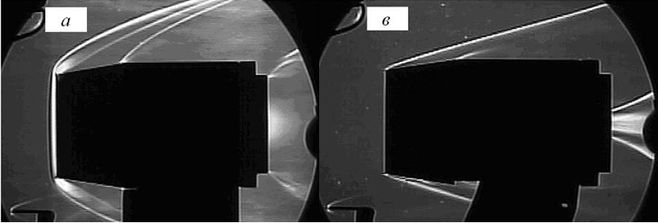
Figure1: Nozzle startup experiment: a - unsuccessful startup if the nozzle is installed before the start of blow down, b - a successful starting if the nozzle is thrown into the airflow at Mach number of 6.

Figure 2: Lines of a constant Mach number against the background of the OH concentration at stable detonative combustion of the hydrogen-air mixture 0.19H2 + 0.21O2 + 0.79N2 at the altitude of 14 km.
Recent Publications
1.Tunik YuV (2010) Numerical modeling of detonation combustion of hydrogen – air mixtures in a convergent – divergent nozzle. Fluid Dynamics. 45(2):264-270.
2.Isakova NP, Kraiko AN, P’yankov KS, Tillyaeva NI (2012) The amplification of weak shock waves in axisymmetric supersonic flow and their reflection from an axis of symmetry. Journal of Applied
- Aero Dynamics | Aero Acoustics | CFD- Methodology | Thermo- Fluid Dynamics
Chair
Konstantinos Kontis,
University of Glasgow, UK
Co-Chair
I V Sharikov
Saint Petersburg Mining University, Russia
Session Introduction
Xesús Nogueira
Universidade da Coruña, Spain
Title: New meshless formulations for aeroacoustics and compressible aerodynamic computations
Time : 10:10-10:30

Biography:
Xesús Nogueira has his expertise in Computational Fluid Dynamics. He earned his PhD degree from University of A Coruña, Spain in 2009. He was Visiting Professor during the period 2011-2012 at Arts et Métiers ParisTech, France, and he is currently an Associate Professor in the Civil Engineering School at University of A Coruña. His research interests are focused on computational fluid mechanics, high-order methods for compressible and incompressible flows. He has received the Juan C Simo Young Investigator Award from SEMNI, the Spanish Society for Numerical Methods in Engineering.
Abstract:
The development of numerical methods for the simulation of problems involving highly complex geometries, which are frequent in many engineering problems, remains a very active research field in computational fluid dynamics (CFD). In the simulation of turbulent flows, for example, high-accurate numerical techniques are required to account for the fine scales of the flow. In these kinds of problems, the construction of a good quality mesh is one of the most time-consuming procedures. Another example is Computational Aeroacoustics (CAA), where the low magnitude of acoustic waves and the wide range of frequencies involved, makes mandatory the use of very accurate numerical schemes. Nowadays, the standard numerical techniques in CAA are mainly grid-based methods. However, the use of Lagrangian methods in the context of CAA may be interesting for problems involving deformable or moving boundaries in the propagation media or multiphase flows, such as combustion noise, sound propagation through multiphase flows or bubble acoustics. Unfortunately, there are very few Lagrangian numerical methods to solve CAA problems in the literature. In this work, we propose a new high-accurate, stable and low- dissipative meshless method based on a Galerkin discretization of a set of conservation equations on an ALE approach, using moving least squares as weight functions for the Galerkin discretization. The stability of the scheme is achieved by the recent a posteriori multi-dimensional optimal order detection paradigm. We apply the numerical scheme to some test cases including CAA (Figure 1) and compressible flows. The proposed numerical method can be seen as a general formulation which includes some well-known meshfree methods. The promising results obtained shown that the proposed scheme can be applied to problems with engineering interest.
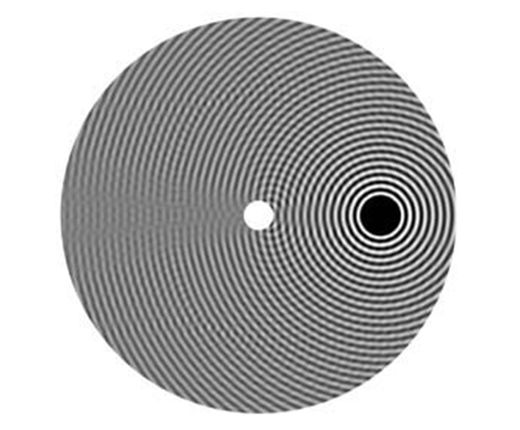
Figure 1: Time-periodic Gaussian source scattering by a circular cylinder computed with the proposed scheme.
Recent Publications
1. Y O Zhang, T Zhang, H Ouyang, T Y Li (2016) Efficient SPH simulation of time-domain acoustic wave propagation. Engineering Analysis with Boundary Elements 62:112-122.
2. S Clain, S Diot, R Loubère (2011) A high-order finite volume method for systems of conservation laws- Multidimensional Optimal Order Detection (MOOD). Journal of Computational Physics 230:4028-4050.
3. J P Vila (1999) On particle weighted methods and smooth particle hydrodynamics. Mathematical Models and Methods in Applied Sciences 9(2):161-209.
4. X Nogueira, L Ramírez, S Clain, R Loubère, L Cueto-Felgueroso and I Colominas (2016) High-accurate SPH method with multidimensional optimal order detection limiting. Computer Methods in Applied Mechanics and Engineering 310:134-155.
5. E Gaburov and K Nitadori (2011) Astrophysical weighted particle magnetohydrodynamics. Monthly Notices of the Royal Astronomical Society 414:129-154.
Piergiacomo Cancelliere
Italian National Fire Rescue and Service – CNVVF – Rome, Italy
Title: CFD analysis and experimental tests of a fire safety pressurized smokeproof enclosure

Biography:
Piergiacomo Cancelliere got his Master’s Degree in Electrical Engineering in April 1998 at the University of Cassino, Italy. He took his PhD in Conversion of Electrical Engineering from the Second University of Naples in 2007. He started his career as an Electrical Engineer working for some relevant electrical enterprises, such as ABB. From June 2001 to April 2006, he was with the Electrical Machines and Drives Research Group of the University of Cassino. In May 2006, he joined the Italian National Fire Rescue and Service. He is currently a Senior Fire Officer. His technical and scientific topics cover both active and passive fire protection measures, fire assessment of electrical installations, components and ATEX related aspects. He is also a member of several TCs of the Italian Electrotechnical Committee and of the Italian technical standardization organization. He has authored more than 50 papers on international, national journals and conference proceedings.
Abstract:
Pressure differential systems have the purpose of maintaining tenable conditions in protected spaces for different types of building safe places like, escape routes, firefighting access routes, lobbies, stairwells and refuge areas. The aim of pressure differential systems is to establish airflow paths from protected spaces at high pressure to spaces at lower or ambient pressure, preventing the spread of toxic gas released during a fire. This strategy ought to be supported by a detailed design of the necessary air supply, considering also the cycle of opening and closing doors during the egress phase. The study deals with the design and experimental test of a simple pressure differential system intended to be used in a building as a pressurized smoke proof enclosure. Experimental tests are conducted in a simple 3 meter side cubic enclosure with two doors and no vent openings (Figure 1 and Figure 2). While a centrifugal fan blows constant airflow inside the structure, pressure trend in time is recorded during steady state and transient conditions; additionally, the velocity of the airflow across the doors has been measured by means of an anemometer. Numerical simulations are carried out to reproduce the same smoke proof enclosure configuration (both geometry and boundary conditions) using Fire Dynamics Simulator (FDS). Furthermore, specific attention is paid to the modelling of the leakage across the doors, directly inserted in the model through a localized HVAC (Heating and Venting Air Conditioning) advanced leakage function. Comparison between experimental tests and numerical simulations are provided. Once the model was correctly calibrated, other geometrical and mechanical configurations have been analyzed and studied, looking for more convenient and efficient positions of the fan to fulfil the requirements of pressure differential, airflow velocity and door handle force. This study highlights some fundamental aspects on the pressurization and depressurization during steady state and transient phases, trying to identify if there are airflow profiles typical of some geometrical configurations.
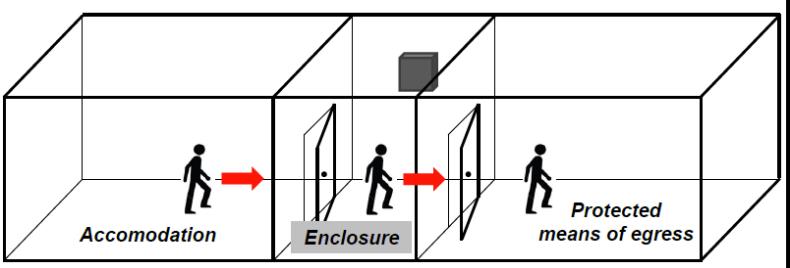
Figure 1: Pressurized fire safety smoke proof enclosure
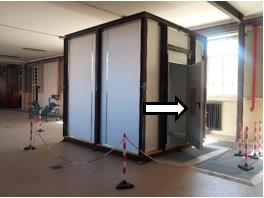
Figure 2: Experimental fire safety smoke proof enclosure
Recent Publications
1. G Gai and P Cancelliere (2017) Design of a pressurized smoke proof enclosure: CFD analysis and experimental tests. Safety doi:10.3390/safety3020013.
2. P Cancelliere (2016) PV electrical plants fire risk assessment and mitigation according to the Italian national fire services guidelines. Fire and Materials 40(3):355–367.
3.P Cancelliere and C Liciotti (2016) Fire behaviour and performance of photovoltaic module backsheets. Fire Technology 52(2):333–348.
Tahir Yavuz
BaÅŸkent University, Turkey
Title: Optimization analysis of the combinations of concentrator and wind turbine with flap in CFD

Biography:
Tahir Yavuz has completed BSc in Mechanical Engineering from Karadeniz Technical University Turkey, and PhD in Aeronautical Engineering, Leicester University, England. He worked at Erciyes and Karadeniz Technical Universities, Turkey and is currently working as a full time Professor at Baskent University, Turkey. He is interested in bluff body aerodynamics, renewable energies such as wind energies and wind turbines. He has developed high-performance wind turbine blades such as airfoil with slat arrangements.
Abstract:
Due to rapidly increasing population and technological advances the demand for energy is increasing day by day. To meet this demand the technology is turning to renewable energy sources rather than fossil fuels. The importance given to wind and hydrokinetic energies is increasing with each passing day. In this context, many studies are done to improve the turbine performance. Today, depending on technological developments, the minimum speed of wind and hydrokinetic current to produce electricity from wind and hydrokinetic turbines is about 3-4 m/s and 1-2 m/s respectively. To generate electricity at lower speed from wind turbine two different studies are performed. The first one is the design of the high-performance blade (such as slatted blade and twin blades), and second one is the design concentrator suitable for turbine to increase wind speed. In this study, the optimization of the combinations of concentrator with wind turbine is curried out. The concentrator and flap geometries and positions highly effect the turbine performance so a numerical optimization method coupled the response surface method with genetic algorithm was employed to obtain concentrator and flap position leading maximum velocity increase at the wind turbine zone. Taguchi optimization method applied to the system without wind turbine gives speed increase in the concentrator is about approximately 2 times. More realistic results will be obtained by Response Surface Methods. Some outputs from the study are presented in Figure 1 and 2. Velocity and pressure distributions in the concentrator obtained at the optimum parameters are given in Figures 1 and 2 respectively. Although Taguchi design can achieve results in less experimentation than full factorial design, this method yields only the optimum result for at the one of the factor levels defined in the optimization study. Therefore, the other optimization method, Response Surface Method, outlined above is used in the optimization. The method will give optimum results in the range of the factor levels defined not at the defined levels. More details will be given in the full paper.

Figure 1: Velocity distribution

Figure 2: Pressure distribution
Recent Publication
1. Hansen M O L, Sørensen N N and Flay R G J (2000) Effect of placing a diffuser around a wind turbine. Wind Energy 3:207-213.
2. Franković B and Vrsalović I (2001) New high profitable wind turbines. Renewable Energy 24:491-499.
3. Matsushima T, Takagi S and Muroyama S (2006) Characteristics of a highly efficient propeller type small wind turbine with a diffuser. Renewable Energy 31:1343-1354.
4.Toshimitsu K, Nishikawa K, Haruki W, Oono S, Takao M and Ohya Y (2008) PIV measurements of flows around the wind turbines with a flanged- diffuser shroud. Journal of Thermal Science 17:375-380.
5. Jamieson P M (2009) Beating Betz: Energy extraction limits in a constrained flow field. Journal Solar Energy Engineering 131:031008-6.
Valery Ya Rudyak
Novosibirsk State University of Architecture and Civil Engineering, Russia
Title: The features of the modeling the nanofluid flows

Biography:
Valery Ya Rudyak has graduated from Physical Faculty (Molecular Physics Department) of the Novosibirsk University. He completed his PhD dissertation in Kinetic Theory Of Gases. In 1990, he defended the Doctor of Science in Physics and Mathematics dissertation. He is Honored Science Worker of Russian Federation. He is Head of Theoretical Mechanics department of the Novosibirsk State University of Architecture and Civil Engineering, simultaneously he is Main Research Scientist of the Siberian Federal University. His main field of expertise includes the following subjects: nonequilibrium statistical mechanics, kinetic theory of gases, rarefied gas dynamics, physics and mechanics of transport processes, transport processes in nanofluids, flows in microchannels, multi-phases fluids, laminar-turbulent transition, CFD and molecular dynamics simulation. He is author of 6 monographs and more than 200 scientific papers. The main subjects of his research are the nanofluids transport properties and modelling micro- and nanoflows.
Abstract:
Nanofluid is two-phase systems consisting of a base fluid and nanoparticles. The study of the physics and transport properties of nanofluids has started relatively recently. It has been motivated by various applications of nanofluids in many different areas. Therefore, modeling the nanofluid flows is the fashion direction in fluid mechanics. However, the standard approaches are not applicable here. This is due to the fact that the nanofluids have no standard properties. In this paper, the features of the nanofluid flows modeling are analyzed and the thermophysical properties of nanofluids are discussed in detail. It was shown that viscosity and thermal conductivity of nanofluids as a rule did not describe by the classical theories. The transport coefficients of nanofluids depend not only on the volume concentration of the particles but also on their size and material. The viscosity increases with decreasing the particle size while the thermal conductivity increases with increasing the particle size, the reasons of such behavior is explained. Last part of the paper deals with the modeling of two important flows, the heat transfer of nanofluid in cylindrical channel and laminar turbulent transition in Poiseulle and tube flows are considered. It was shown that the heat transfer coefficient is determined by the flow mode (laminar or turbulent) of the nanofluid. The use of the nanofluids as a coolant significantly affect the magnitude of the heat transfer coefficient. The laminar-turbulent transition begins in all cases earlier (at smaller Reynolds numbers) than carrier fluid. In conclusion, the possibility of the use of traditional similarity criteria are discussed. It is shown that the variation in the Prandtl number during modeling does not allow obtaining adequate information about the flow under study, since each point of the obtained dependences corresponds to different nanofluids simply.

Figure 1: Structure of the presentation.
Recent Publications
1. Podryabinkin E V and Rudyak V Y (2014) Modeling of turbulent annular flows of Hershel-Bulkley fluids with eccentricity and inner cylinder rotation. Journal of Engineering Thermophysics 23:137-147.
2 Rudyak V Ya and Krasnolutskii S L (2014) Dependence of the viscosity of nanofluids on nanoparticle size and material. Physics Letters A 378:1845-1849.
3 Rudyak V and Minakov A (2014) Modeling and optimization of Y-type micromixers. Micromachines 5:886-912.
4.Minakov A V, Lobasov A S, Guzei D V, Pryazhnikov M I and Rudyak V Ya (2015) The experimental and theoretical study of laminar forced convection of nanofluids in the round channel. Applied Thermal Engineering 88:140-148.
5 Gavrilov A A and Rudyak V Ya (2016) Direct numerical simulation of the turbulent flows of power-law fluids in a circular pipe. Thermophysics and Aeromechanics 23:47-487.
Konstantinos Kontis
University of Glasgow, UK
Title: High speed aerodynamic phenomena and interactions including their control

Biography:
Konstantinos Kontis is the Sir Henry Mechan Chair of Engineering, Professor of Aerospace Engineering, and Head of the Aerospace Sciences Division at the University of Glasgow, UK. He has been Visiting Professor in several organizations worldwide. He is a member of several committees and working groups, where he contributes to European, UK, and US Aeronautics and Space Strategy. He is a Fellow of the Royal Aeronautical Society and the Institution of Mechanical Engineers, London, UK, and a Fellow of AIAA, USA. His other principal professional qualifications are: EurIng, CEng. His research field of expertise are: aerospace vehicle design, integrated wing configurations, aerodynamics, wind tunnel testing, flow control and flow diagnostics.
Abstract:
The National Wind Tunnel and Testing Facilities Centre at the University of Glasgow is investigating complicated flow problems and interactions related to flight, load and noise control, unsteady aerodynamics, bio-inspired flows, interdisciplinary shock wave phenomena, turbulence, instabilities and multi-phase flows, and the development and application of advanced flow diagnostics and CFD solvers. The main focus of the presentation will be on recent developments in flow diagnostics associated with high speed flows. Examples will include: flow control, transition, intakes etc. An overview of the Aerospace Sciences Division research activities will be provided. The importance of external engagement and internationalization in generating impact in fluid dynamics research, and synergy between the different disciplines in the advancement of aerospace sciences will be also discussed.
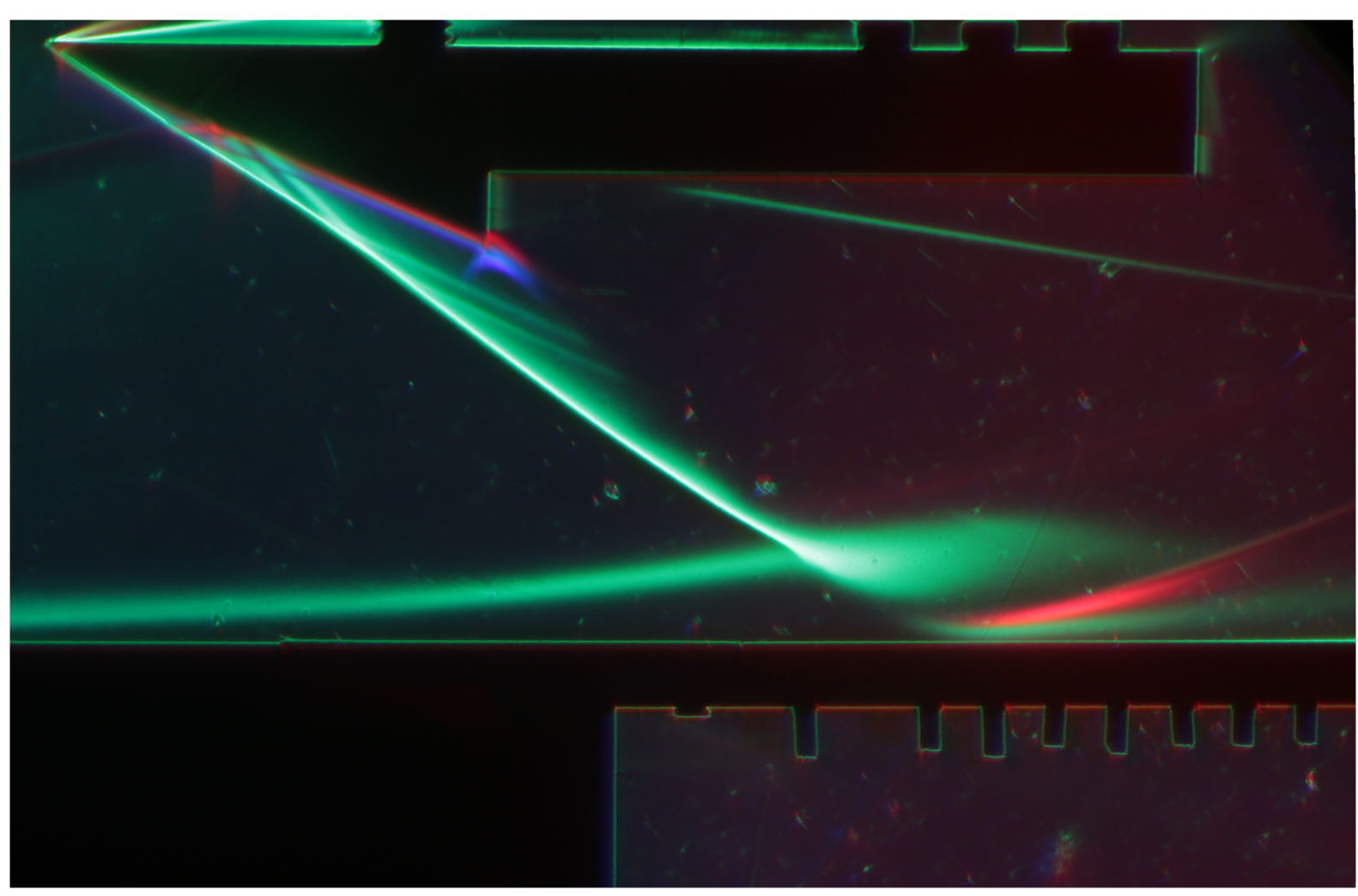
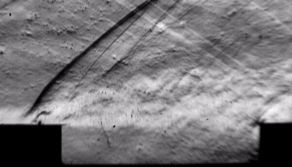
Recent Publications
1.Lo K H and Kontis K (2017) Flow characteristics of various three-dimensional rounded contour bumps in a Mach 1.3 freestream. Experimental Thermal and Fluid Science 80:228-243.
2.Ukai T, Zare-Behtash H, Kontis K and Erdem E (2017) Experimental investigation of surface flow pattern on truncated cones in Mach 5 flow: influence of truncation ratio. Experimental Thermal and Fluid Science, 81:396-405.
3.Ukai T, Zare-Behtash H, Kontis K and Obayashi S (2016) Three-Dimensional shock wave distortion in shock-square vortex loop interaction. Experimental Thermal and Fluid Science 79:85-90.
4.Gnani F, Zare-Behtash H and Kontis K (2016) Pseudo-shock waves and their interactions in high-speed intakes. Progress in Aerospace Sciences 82:36-56.
5.Russell A, Zare-Behtash H and Kontis K (2016) Joule heating flow control methods for high-speed flows. Journal of Electrostatics 80:34-68.
Cuiwei Liu
China University of Petroleum, China
Title: Computational fluid dynamic simulation of leakage acoustic waves propagation model for gas pipelines

Biography:
Cuiwei Liu is a Lecturer in Oil and Gas Storage and Transportation Engineering in China University of Petroleum. His research emphases include leak detection, location for oil and gas pipelines based on acoustic waves and dynamic pressure waves. In recent years, he has made successful researches on generation and propagation mechanism of leakage acoustic waves based on aero-acoustics and fluid dynamics. In his work published in the Journal of Loss Prevention in the Process Industries (JLPPI, 2014) he showed the acoustic generation mechanism based on the gas-solid interaction. In his work published in Computers and Fluids (CAF, 2015), he carried out computational fluid dynamic simulation of pressure perturbations generation for gas pipelines leakage. Also, he studied the propagation model of acoustic waves in the gas in the pipeline.
Abstract:
When leakage occurs for natural gas pipelines, acoustic waves generated at the leakage point will propagate to both ends of the pipe, which will be measured and processed to detect and locate the leakage. When acoustic waves propagate in the gas, the amplitude will attenuate and the waveform will spread, which decides the installation distance of acoustic sensors. Therefore, a computational fluid dynamic (CFD) simulation research on the acoustic waves propagation model is accomplished and verified by experiments to provide foundation for acoustic leak location method. The propagation model includes two parts: amplitude attenuation model and waveform spreading model. Both can be obtained by the established CFD simulation model. And the amplitude attenuation model can be verified by the experiments. Then, the simulation method is applied to conclude the propagation model under variable conditions including different flow directions, Reynolds numbers and diameters. Finally, the experimental demonstration of the leak location based on the propagation model is given. The results indicate that not only the gas viscosity but also the gas flow can influence on the propagation model and leak location method based on propagation model is effective. Conclusions can be drawn that CFD simulation on the propagation model for natural gas pipelines is an efficient way to carry out research and provide theoretical basis for acoustic leak location method application.
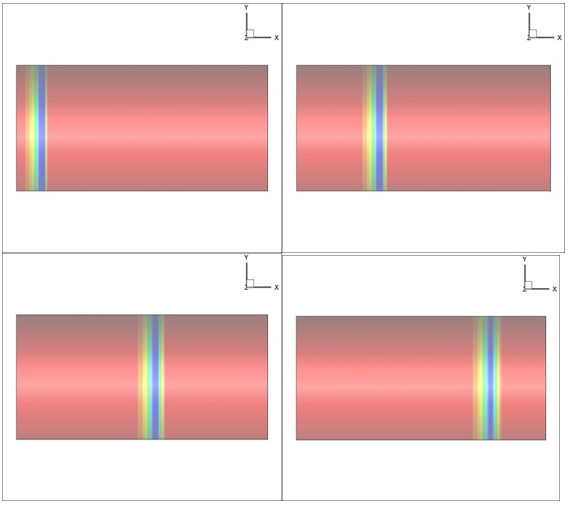
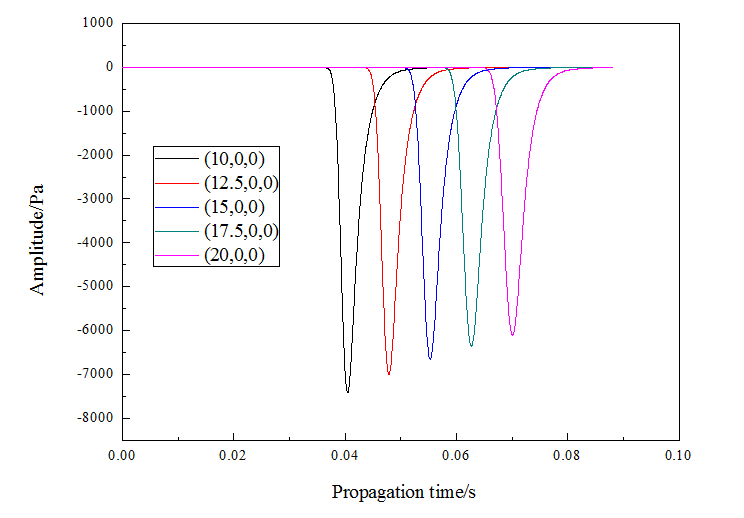
Recent Publications
1. Cuiwei Liu, Yuxing Li, Liping Fang and Minghai Xu (2017) Experimental study on a de-noising system for gas and oil pipelines based on an acoustic leak detection and location method. International Journal of Pressure Vessels & Piping, 151:20-34.
2. Cuiwei Liu, Yuxing Li, Liping Fang, Jinke Han and Minghai Xu (2017) Leakage monitoring research and design for natural gas pipelines based on dynamic pressure waves. Journal of Process Control, 50:66-76.
T Pyragiene
Center for Physical Sciences and Technology, Lithuania
Title: Anticipating of chaotic dynamics via schemes without time-delay terms

Biography:
Tatjana Pyragiene takes part in the investigation of the phenomenon of anticipating chaotic synchronization from 2008 till now. In our paper, Phys. Rev. E (2008) 78: 046217 , a new coupling scheme is proposed which solves one of the main problems of dynamics prediction - to enlarge the prediction time. In this scheme, a response system possesses a time-delay term which causes a lot of difficulties in the analysis and implementation of the method. Then, applying approximated mathematical methods, simple effective coupling schemes are constructed . They provide an approximated dynamics prediction which is good enough for many applications. For example, for neuron systems, only spikes prediction is important as is shown in our paper, Nonlinear Dyn (2013) 74:297. Recently proposed coupling schemes are described in this report.
Abstract:
One of the ways to forecast the chaotic dynamics is applying of anticipating synchronization (AS). This phenomenon appears in the configuration “drive -response” or “master - slave” where a response system anticipates the dynamics of a drive system. The most popular AS schemes contain a time-delay term in the response system which makes the system dimension infinitesimal. Therefore, analytical and experimental treatments of those schemes become complicated. To simplify the analyzing and implementation of AS schemes, algorithms without time-delay terms were proposed. In this case, the forecasting of the drive’s dynamics is not exact, but it is good enough for practical applications. In our works, we realize the regime of anticipating synchronization via introducing two schemes without time-delay terms. The first scheme consists of three chaotic systems: a master system, an intermediate slave system and a terminate slave system. The whole system periodically performs such procedures. The period is divided into three parts. In the first part of the period, the master and the intermediate systems completely synchronize. In the second part, all three systems evolve separately and the intermediate slave system accelerates. In the final third part, the intermediate and terminate slave systems synchronize. The optimal system parameters values were found analytically. Numerical simulations for the typical chaotic systems, namely for the Rössler as well for the neuron Hindmarsh-Rose system, demonstrate a stable AS regime. In our second scheme, we change a time-delay term in the classical Voss scheme by lower order all pass filter (LOAPF). The filter is constructed making use of the methods of the Padé approximation and the Laplace transform. The effectiveness of the scheme is demonstrated for an analytical spiral model and for the chaotic Rössler system. Numerical simulations show that for the filter of the second order (and higher), results coincide with the results obtained with the classical scheme with a time-delay term. The both presented schemes demonstrate that the excluding of a time-delay term simplifies both analytical and numerical investigations of the phenomenon of anticipating synchronization.
Recent Publications
1. Voss H (2000) Anticipating chaotic synchronization. Phys. Rev. E. 61(5):5115.
2. Corron N J, Blakely J N, Pethel S D (2005) Lag and anticipating synchronization without time-delay coupling. Chaos. 15(2):23110.
3. Pyragiene T, Pyragas K (2015) Anticipating synchronization in a chain of chaotic oscillators with switching parameters. Phys. Lett. A. 379(47-48):3084-3089.
4. Rossler E (1976). An equation for continuous chaos. Phys. Lett. A. 57A(5):397.
5. Hindmarsh J I, Rose R M (1984) A model of neuronal bursting using three coupled first order differential equations. Proc. R. Soc. Lond. B, Biol. Sci. 221(1222):87-92.
Suthyvann Sor
INTA, Spain
Title: Aerodynamic characterization of new filters of bioaerosol for INTA investigation aerial platforms
Time : 12:50-13:10

Biography:
Dr. SuthyvannSorMendi is an aerospace engineer and has been working at INTA since 1992. He became the head of Advanced Experimental Technique Laboratory in 2000 in the Experimental Aerodynamic Area at INTA. He has been involved in several European projects (GARTEUR AG-37, EXTICE) and National project (ACE-PCOR).He has also been involved in the NASA/INTA cooperation on Icing (2010-2016), in which he has developed his PhD on droplet deformation, and trajectory near the leading edge of an airfoil, and he has authored more than 10 papers related to Icing Physics. Currently Dr. Sor is involved in National projects (DFLOW, MEDA, MICRA) funded by the Spanish Ministries of Economy and Competitiveness.
Abstract:
Statement of the Problem: A prototype of a new filter of bioaersol particles dedicated to biology investigations has been developed. This prototype was designed to be installed on board investigation aerial platforms of INTA. The air, that contains the particles, enters the filter in the upper side. Then the air encounters a mechanical deflector that throws the air and the particles towards the side walls, where particles are collected. Additionally, a high voltage difference is created between the mechanical deflector electrode and the outer metallic plates acting as sides walls, to pull the charged particles to the side walls increasing the number of particles collected. In the down side, a cylindrical tube that has a spline hole in the down side is connected to a vacuum pump that creates a bi dimensional movement of the air. The experimental characterization of the aerodynamic flow was performed to investigate the behavior of the filter when different air intake velocities and different mechanical deflector geometries are employed.
Methodology & Theoretical Orientation: Five different impactor filters have been investigated by means of PIV measurements. The width of the filter was 100 mm and the filter span was 200 mm. The air intake velocity ranged from 9 m/s to 20 m/s.
Conclusion & Significance: Five filters have been investigated by means of PIV measurements. If the air intake width is decreased, the velocities obtained are higher for the same mass suction. However, the ratio of the horizontal velocity in the impact zone in the wall and the intake velocity decreases. Increasing the plate deflector width increases 10% the velocity between the deflector and the collector walls. However, a gradual deflector allows greater velocities and the impact of the particles in the mechanical deflector is minimum
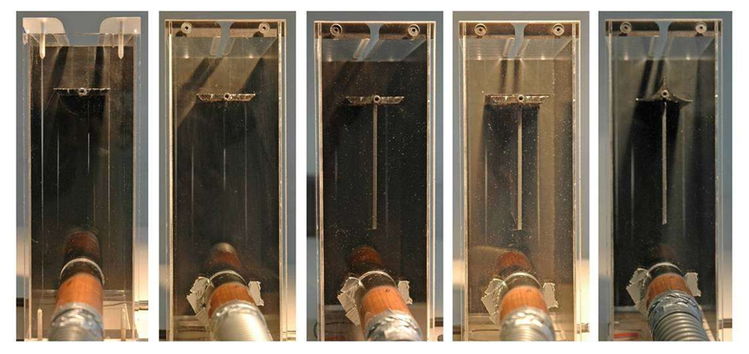
Recent Publications
1. Dechraksa J, Suwandecha T, Maliwan K, Srichana T (2014). The Comparison of Fluid Dynamics Parameters in an Andersen Cascade Impactor Equipped with and Without a Preseparator. AAPSPharmSciTech. 5(3):792-801.
2. King M D, McFarland A R (2012) Use of an Andersen Bioaerosol Sampler to Simultaneously Provide Culturable Particle and Culturable Organism Size Distributions. Aerosol Science and Technology. 46(8):852-861.
3. Meheust D, Gangneux J P, Le Cann P (2013) Comparative evaluation of three impactor samplers for measuring airborne bacteria and fungi concentrations. Journal of Occupational and Environmental Hygiene. 10:455-459.
4. Pastuszka J S, Iwasiewicz P, BrÄ…goszewska E (2013) Preliminary testing of a new bioaerosol sampler developed for the measurements of low and medium concentration levels of airborne bacteria and fungi. Environment Protection Engineering. 39(1):129-138.
5. Simon X, Bau S, Bemer D, Duquenne P (2015) Measurement of electrical charges carried by airborne bacteria laboratory-generated using a single-pass bubbling aerosolizer. Particuology. 18:179 -185.
Moise Y Koffi
Hostos Community College, USA
Title: Flow structure in the vicinity of flapping elephants’ pinnae and thermal implications

Biography:
Moise Y Koffi has his expertise in the flow induced by rotationally oscillating flat plates. His investigation model based is on Computational Fluid dynamics (CFD) simulation with Ansys Fluent examines flow parameters and local surface thermal characteristics in the vicinity of rotating devices. His experimental method using flow visualization techniques gives an illustration of fluid dynamics and nature. As he explores new techniques of cooling and locomotion based on rotationally oscillatory devices he has passion using an engineering approach to analyze biological systems.
Abstract:
The study of the flow induced by rotationally oscillating surfaces has sparked scientific interest in recent decades due to its expanding applications to several areas. However, limited experimental data on such flows are found in previous work. The current study focuses on the flow originated by the flapping of elephants’ pinnae. Due to their large size, elephants produce tremendous metabolic heat. However, how they dissipate their heat has been disputed for decades. It is hypothesized that the flapping of their pinnae is the principal thermoregulatory mechanism for elephants. The present experimental and computational work investigates the flow structure in the vicinity of a flapping elephant pinna and analyzes its impact on the animal’s heat dissipation. Two models of elephant pinnae, one flexible and one rigid were fabricated and tested in the laboratory using flow visualization techniques with smoke particles. Small size J-types thermocouples were used to monitor the surface temperature of the pinna models over flapping cycles, while a constant heat flux was applied to both sides. A 3-D computational investigation of the flow and surface thermal characteristics in the vicinity of a pinna model was carried with fluent using the dynamic mesh method. Computer simulations and flow visualization results revealed the presence of a hook-shaped vortex at the edge of the moving pinnae. The time-dependent surface temperature of the pinna reaches an asymptotic profile at steady state. A significant interaction between the vortical structures shed off the edge and the pinna’s model's boundary layer was found from the flow visualization results, which leads to heat transfer enhancement. The cooling rate of the pinna is improved by 30% for the flexible model compared to the rigid one. In conclusion, elephants flap their pinnae for thermal comfort. Recommendations are made to consider this key information in elephants’ conservation

Recent Publications
1. Koffi M, Y Andreopoulos and L Jiji (2017) Heat transfer enhancement by induced vortices in the vicinity of a rotationally oscillating heated plate. International Journal of Heat and Mass Transfer 112:862-875.
2. Koffi M, Y Andreopoulos and L Jiji (2014) The role of pinnae flapping motion on elephant metabolic heat dissipation. Journal of Heat Transfer 136(10):101101.
Hyun Muk Kim
Pukyong National University, South Korea
Title: Missile-motion performance analysis of gas-steam launch system utilizing multiphase flow model and dynamic grid system
Time : 14:25-14:45

Biography:
Hyun Muk Kim is pursuing his Master's Degree from Pukyong National University in Busan, South Korea. He belongs to the Propulsion and Combustion Laboratory. He majors in Computational Fluid Dynamics, and has been conducting research on thrust performance and combustion characteristics by modeling numerical simulation of methane-oxygen bipropellant thruster as well as on gas-steam launch system.
Abstract:
A gas-steam launch is the method of ejecting a missile from a canister using gas generator rather than a propellant of the missile itself, and it has been studied in various countries. In this system, coolant is injected to the conduit and mixed with combustion gas to prevent the damage to the canister and missile caused by the hot combustion gas. The factors related to pressure build-up, such as temperature change due to an interaction of high temperature gas and coolant as well as the volume increase of a breech (Figure: 1) caused by the movement of the missile, are intertwined, making it difficult to predict the behavior of the missile ejection. In this study, thermo-fluid dynamic phenomenon in the breech was analyzed utilizing ANSYS Fluent and the motion performance of the missile was predicted. To represent the missile motion, the calculation was performed using the dynamic grid system, and DPM (Discrete Phase Model) was used to simulate a process of atomization and evaporation of liquid coolant. The realizable k-ε model was employed for turbulence modeling. Parametric study was carried out by varying the coolant flow rate with the flow rate of high temperature gas fixed, to verify the 3-D DPM numerical analysis model, the simulation results were compared with those obtained from the calculation of the one-dimensional governing equations of C T Edquist, who presented a gas dynamic model to predict the gas-steam launch process of the peacekeeper ballistic missile and compared it with experimental data with a fairly good agreement.
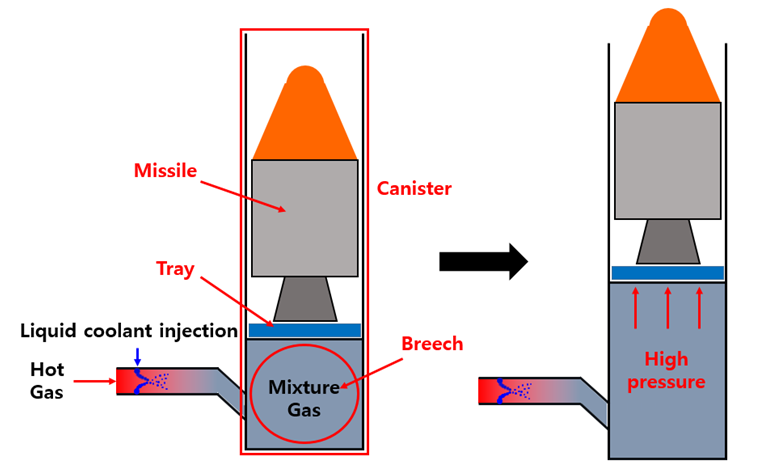
Figure 1: Scheme of canister-launched missile system.
Recent Publications
1.Jong-Ryul B (2001) Analytical study on the launching system with gas generator. Journal of the Korean society of propulsion engineers 5:3:25-59.
2.GookHyun B and Yoo-Jin Y (2005) Coolant effect gas generator propellant. Journal of the Korean society of Propulsion Engineers 9:2:1-8.
3.Yongquan L, Anmin X (2013) An interior trajectory simulation of the gas-steam missile ejection. Journal of Computers 8(5):1321-1326.
- Young Researchers Forum
Session Introduction
Lin Zheng
Beijing University of Technology, China
Title: Finite-time blow-up for the 3-D primitive equations of oceanic and atmospheric dynamics
Time : 14:45-15:00

Biography:
Abstract:
In this paper, we prove that for certain class of initial data, the corresponding solutions of the 3-D primitive equations of oceanic and atmospheric without viscosity and with periodic boundary conditions blow up in finite time. We reduce the unknown function of the three dimensional by constructing special solution and consider the restriction of the evolution of equation on the surface x=0, y=0. Furthermore, we construct a self-similar solution to solve the blow-up problem.
Recent Publications
1. C J Liu, Y G Wang and T Yang (2014) A well-posedness theory for the Prandtl equations in three space variables. Adv. Math. 308:1074--1126.
2. C. Cao,Slim,J. K. Li, E. S. Titi (2012) Finite-time blowup for the inviscid primitive equations of oceanic and atmospheric dynamics. Comm. Math. Phys. 337:473--482.
3. C. Cao,J. k. Li, E. S. Titi (2014)Global well-posedness of strong solutions to the 3D primitive equations with horizontal eddy diffusivty. JDE 257:4108--4132.
4. C. Cao, E. S. Titi (2012) Global well-posedness of the three-dimensional straified primitive equations with partial vertical mixing turbulence diffusion. Comm. Math.Phys. 310: 537--568.
5. B. Guo, D. Huang (2011) Existence of the universal attractor for the 3D viscous primitive equations of large-scale moist atmosphere. JDE. 47: 457--491.
Na Wang
Beijing University of Technology, China
Title: The boundary layer problem on the incompressible MHD system with noncharacteristic Dirichlet boundary condition for velocity
Time : 15:00-15:15

Biography:
Na Wang is mainly engaged in the study of partial differential equations of fluid mechanics, especially the study of boundary layer problems in MHD system.
Abstract:
In this paper, we study the boundary layer and vanishing viscosity-diffusion limit problem for the incompressible magneto-hydrodynamic (MHD) system, which has the non-characteristic Dirichlet boundary condition for the velocity and the perfect conducting wall boundary condition for the magnetic field. Using the multiscale analysis and asymptotic expansion approach, we can obtain the inner function equations and boundary layer equations. By solving the boundary layer equations, we find that the velocity has the low order boundary layer, and the magnetic field has the high order boundary layer. Then we use the inner functions and the boundary layer functions to construct the approximate solutions. At last, utilizing the elaborate energy methods, we can strictly prove that the solutions of the viscous and diffuse MHD system can be approximated by the approximate solutions when the viscosity and diffusion coefficient tend to zero.
Recent Publications
1.Wang S, Wang B Y, Liu C D, Wang Na (2017) Boundary layer problem and zero viscosity-diffusion limit of the incompressible magnetohydrodynamic system with no-slip boundary conditions. Journal of Differential Equation doi: 10.1016/j.jde.2017.05.025.
2.Guo B L and Wang G W (2016) Vanishing viscosity limit for the 3D magnetohydrodynamic system with generalized Navier slip boundary conditions. Mathematical Methods in the Applied Sciences 39:4526-4534.
3.Wu Z L and Wang S (2015) Zero viscosity and diffusion vanishing limit of the incompressible magnetohydrodynamic system with perfectly conducting wall. Nonlinear Analysis: Real World Applications 24:50-60.
4.Xie X Q, Luo L and Li C M (2014) Boundary layer for MHD equations with the non-characteristic boundary conditions (in Chinese). Chinese Annals of Mathematics 35A(2):171-192.
5. Xiao Y L, Xin Z P and Wu J H (2009) Vanishing viscosity limit for the 3D magnetohydrodynamic system with a slip boundary condition. Journal of Functional Analysis 257:3375-3394.

Biography:
Seyfi Girgin has a Bachelor’s degree in Mechanical Engineering and Master’s degree in Aerospace Engineering. His expertise is based on CFD models and thermal managements. He has performed this study for his Master’s thesis. He is developing his approach on this study to perform heat transfer enhancement on fighter aircrafts. He is now working in a company as a Research and Development Engineer specialized in Thermal System Design Engineering.
Abstract:
Statement of the Problem: The need of high performance of thermal systems in many engineering applications has increased. The convectional heat exchangers are generally improved by surface augmentation. There are two enhancement techniques of convective heat transfer for compact heat exchangers. One is to extend heat transfer surface area like a fin, the other is to increase heat transfer coefficient between solid surface and fluid such as using turbulators as vortex generators. The purpose of this study is to increase the intensity of secondary flow and reduce the size of wake regions in rectangular plate fin heat exchangers os as to increase to heat transfer coefficient to gain size and effectiveness. In this study, a new type of vortex generator called common flow up-common flow down and its various configurations reported.
Methodology & Theoretical Orientation: In rectangular channel, three configurations have been analyzed; common flow up, common flow down and mix type (both up and down) with 15-30-45 and 60-degree wings attack angle. The height of the vortex pair is half of the channel height.
Findings: 3D CFD results showed that 30-degree common flow up configuration provides the better heat transfer rate under the same inlet velocity and temperature. 15-45 and 60 degree increases the heat transfer rates about 26%-33% and 42% while 30-degree configuration gives 59% more heat transfer performance compared to channel without vortex generators. However, at that configuration, pressure drop penalty occurs which is about 34% more pressure drop compared to channel without vortex generators pairs. Results showed that wings attack angel play an important role in determining the heat transfer performance. In detailed results; Nusselt number, Reynolds number, pressure drop, heat transfer coefficient and corresponding vortex generator configurations are compared. Further studies can be based on the effect of length, height and placement of the vortex generators.
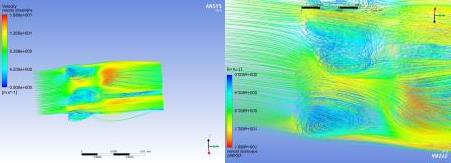
Figure 1: Velocity streamlines over 30-degree common flow up type heat exchanger
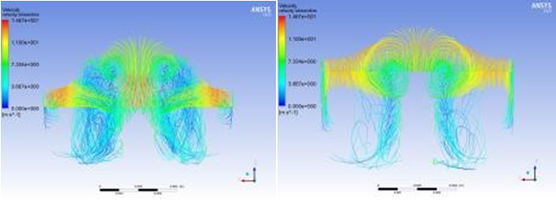
Figure 2: Velocity streamlines at z=5 and z=7 mm (30-degree common flow up)
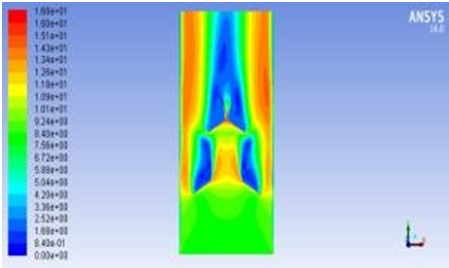
Figure 3: Velocity contours at Re=2000, 30-degree common flow type
J Alfredo Soto Ã,
University of Guanajuato, Mexico
Title: Blood flow analysis in presence of static magnetic field of 3.0 T
Biography:
J Alfredo Soto Á is a Physicist who has acquired experience in Medical Physics and its union with Computational Fluid Dynamics. He has also been in contact with MRI machines, originating interest in the interaction of magnetic fields with biofluids. Until now, he has worked only with the numerical technique of finite differences but he has a great interest in extending his research to element and finite volume.
Abstract:
Interactions with a high intensity static magnetic field (0.2 T to 3.0 T) are widespread practice in a Magnetic Resonance Imaging study, hence, it is important to know the side effects associated with such exposures. In this work, a mathematical model and its numerical treatment is presented for a physical system that describes an artery segment through which oxygenated blood flows while being exposed to a 3.0 T magnetic field. The model uses the thermodynamics theory to propose an isothermal system and the generated energy of the magnetic field. An expression for the new pressure is derived to be coupled with the Navier-Stokes equations. Given the geometry and symmetry of the physical system under analysis, as a first approximation, a rectangular cavity is used for the numerical solution of the governing equations using the finite difference method. The code of the numerical method for the rectangular cavity was validated before being coupled to the raised problem. Results suggest that given the changes established by the presence of the magnetic field in the thermodynamic system, there are modifications in the speed profile as also in the blood flow.
Recent Publications
1. E E Tzirtzilakis (2005) A mathematical model for blood flow in magnetic field. Physics of Fluids 17:077103-1.
2.C T Phua and G Lissorgues (2009) Modeling of pulsatile blood flow in a weak magnetic field. World Academic Science, Engineering and Technology 54:73-76.
3.N Rusli, E H Kasiman, A K B Hong, A Y M Yassin and N Amin (2011) Numerical computation of a two-dimensional Navier-Stokes equation using an improved finite difference method. Matematika 27(1):1-9.
4. N Rusli, A B H Kueh and E H Kasiman (2011) Staggered grid computation of fluid flow with an improved discretization of finite differencing, ICIEIS, Part III, Communication in Computer and Information System 253:82-94.
- Poster Presentations

Chair
Piergiacomo Cancelliere
Italian National Fire Rescue and Service – CNVVF – Rome, Italy
Session Introduction
Yutaro Takahashi
Akita University, Japan
Title: Power consumption of liquid atomization device by using rising film flow along a rotating cone and disk
Biography:
Abstract:
Mist is an atomized state of liquid, where many droplets are clustered and dispersed. If the mist is sprayed around and comes in contact with surrounding objects, the mist evaporates quickly and it does not wet the object. Therefore, it is used indoors as a part of such devices as a humidifier and a mist sauna. In addition, since heat absorption occurs in the process of evaporation of droplets, the mist is used outdoors as a cooling facility in buildings and parks. In a process of mist generation, it is common to use an atomization system by using several devices such as pumps, compressors, nozzles and fans. Because many devices are needed, the atomization system becomes larger and complicated. So, the system maintenance is difficult, leading to trouble and accident. Considering the above situation, Adachi et al. invented a new atomization device using a rotating cone and disk shown in Figure1. The device uses a phenomenon that liquid rises along the conical outer surface when the cone is immersed in the liquid by turning the top upside down and rotated as seen in Figure 2. In addition, the rising liquid is spread by a rotating disk, and the spread liquid is sprayed as mist indicated in Figure 3. Because any mechanically complicated parts are not immersed into the water, the device is easy to maintain. It is important to know necessary power of the atomization device. Therefore, we investigate the necessary power by varying the rotation speed of cone and mist flow rate. In addition, we aim to derive a dimensionless correlation equation using a power number Np.

Figure 1: Experimental apparatus

Figure 2: Visualization photographs of rising film flow.

Figure 3: Visualization photograph of mist flow sprayed from the disk edge.
Recent Publication
1. T Adachi, N Sato, N Kobari and T Hori (2010) Liquid film flow rising along the outer surface of the rotating cone. Heat Transfer Asian Research 39:492-496.
2. T Adachi (2013) Enhancement of oxygen dissolution using mist flow generated by a rotating cone. Japan Society of Mechanical Engineers Series B (in Japanese) 79(800):632-635.
3. T Adachi (2015) Oxygen transfer and power consumption in an aeration system. Chemical Engineering Science 126:625-632.
![]()
Satoshi Hotta
Akita University, Japan
Title: Pressure drop evaluation of heat exchanger model with disturbance promoters

Biography:
Satoshi Hotta is a Graduate School Student in Akita University. He is engaged in measurement for pressure drop characteristics in model channels of plate-type heat exchangers. The plate-type heat exchanger is used especially in a field of Ocean Thermal Energy Conversion (OTEC) system to generate power from natural resources. To achieve the development of high efficiency for the OTEC power plant, he collaborates stuffs in Institute Ocean Energy, Saga University, which is a core institute for OTEC in Japan.
Abstract:
Heat transfer technology works in various aspects such as industrial products. Especially for the plate type heat exchanger, it is highly valued in terms of high thermal efficiency and compact size, etc. It is thought that the application range of the plate type heat exchanger will further widen in the future. For this heat exchanger, a method of disturbing flow using a disturbance promoter is attracting attention as a method for increasing thermal efficiency. In this study, consider the trapezoidal groove in the disturbance promoter, and consider its performance. The visualization of the disturbance promoter in the trapezoidal groove is shown in Figure 1. The feature of this promoter is that a vortex is generated in the groove. This feature doesn’t have smooth disturbance promoter. Two things need to be considered in evaluating the disturbance promoter; first, about heat transfer, the second, about energy loss. In this study, we consider energy loss in the channel. The energy loss can be expressed by the difference in pressure drop between the two points by Bernoulli theorem. Therefore, in this study energy loss is considered by measuring pressure loss. The experiment apparatus is shown in Figure 2. The flow rate was adjusted with a valve, and the pressure drop when a constant flow rate was passed was measured. The plate pattern of the disturbance promoter was measured for 6 patterns as shown in Figure 3. As a result, it was found that there is a critical point at which the loss significantly increases in any pattern. This is a phenomenon that is expected to change the turbulent flow from laminar flow to turbulent flow. It was also found that the critical point was affected with respect to the edge part with respect to the flow direction.

Figure 1: Flow visualization
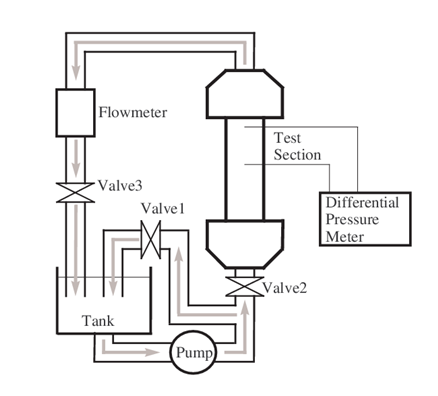
Figure 2: Experiment apparatus

Figure 3: Plate pattern
Recent Publications
1. T Adachi, Y Tashiro, H Arima and Y Ikegami (2009) Pressure drop characteristics of flow in a symmetric channel with periodically expanded grooves. Chemical Engineering Science 64:593-597.
2.T Adachi and S Hasegawa (2006) Transition of the flow in a symmetric channel with periodically expanded grooves. Chemical Engineering Science, 61:2721-2729.
3.T Adachi, Y Goshi and H Uehara (2002) Transition and pressure drop characteristics of flow in periodically combined channels. JSME International Journal Series B, 68:2232-2239.
4.T Adachi and H Uehara (2001) Correlation between heat transfer and pressure drop in channels with periodically grooved parts. International Journal of Heat and Mass Transfer 44:4333-4343.
Aleksei Greshilov
Lavrentyev Institute of Hydrodynamics of SB RAS, Russia
Title: Dynamic impact on a frozen support caused by natural and quasinatural oscillations of an ice plate

Biography:
Aleksei Greshilov graduated from Novosibirsk State University (NSU) in 2012 with a Master's Degree. Currently, he is a Junior Researcher at the Lavrentyev Institute of Hydrodynamics, SB RAS and is working on his PhD thesis on the theme of Polar Mechanics. He has publications in using the theory of long waves in shallow water and the approximation of the Euler beam vibrations was studied of the behavior of thin elastic plates.
Abstract:
Interest in the problem of ice plate oscillations is due to its wide usage in many practical applications and engineering calculations (design of floating platforms, installation of oil rigs in the polar environment, creation of airfields on ice, etc.). It should be noted that there are projects of giant floating facilities (airports and islands) based on the floating plate concept. The aim of this work is to study the behavior of an elastic plate frozen onto a vertical support and floating on the surface of an ideal incompressible fluid in the case of bounded and unbounded reservoirs and to determine the dynamic loads on the vertical support considering the unevenness of the bottom. The purpose is to consider the asymptotic behavior of natural frequencies with the endlessly increasing reservoir radius and determine the dependence of the natural oscillation frequencies of the plate on the natural oscillation frequencies of the free water surface in a closed reservoir (seiches). Here the natural and quasinatural oscillations of the elastic plate floating on the surface of an ideal incompressible fluid are considered within the linear shallow water theory.

Recent Publications
1. A G Greshilov (2017) Chladni figures of a circular plate floating in the bounded and unbounded water basins with the cantilevered central support. Journal of Applied and Industrial Mathematics 11(1):49–57.
2. A A Korobkin and T I Khabakhpasheva (2007) Construction of exact solutions of a problem concerning a floating plate. Journal of Applied Mathematics and Mechanics 71(2):321–328.
3. I V Sturova (2008) Effect of Bottom Topography on the Unsteady Behavior of an Elastic Plate Floating on Shallow Water. Journal of Applied Mathematics and Mechanics 72(4):417–426.
4.V V Alekseev, D A Indeitsev and Yu A Mochalova (2002) Vibration of a flexible plate in contact with the free surface of a heavy liquid. Technical Physics 47(5):529–534.
5. G Zilman and T Miloh (2000) Hydro-elastic buoyant circular plate in shallow water: a closed form solution. Applied Ocean Research 22:191–198.

Biography:
Luc R Pastur has expertise in Aerodynamics and Dynamical System Theory. His work on open cavity flows has covered the study of both the shear-layer self-sustained oscillations and centrifugal instabilities that may develop in the inner-flow, at lower Reynolds numbers. More recently, he started to investigate wake bi-stability of bluff bodies, in collaboration with Olivier Cadot, a phenomenon only recently discovered by the fluid dynamics community, despite its generic occurrence in almost any fluid configurations involving three-dimensional bluff bodies
Abstract:
Recent studies have shown that beyond some critical value of the ground clearance and Reynolds number, turbulent wakes past bluff bodies may undergo antisymmetric instabilities that result into the (steady) defelection of the wake in the direction of the body main shape ratio. As a consequence, additional lateral forces apply to the body, and temporally intermittent shifts from one deflected position to the symmetrical position are most usually observed. This resulting pitchfork bifurcation can be imperfect, when the yaw angle is non-vanishing. For moderate yaw angles, the wake can be blocked into one of the two allowed deflected positions. The lifetime of the wake, in a given deflected position, is larger by orders of magnitude than the characteristic vortex shedding time. Lifetime distributions follow Poisson-like probability laws, indicating a memory-less process. In this presentation, we propose to review the main results we gathered from several campaigns of measurements on flat backed 3D bluff bodies bluff bodies, over the last five years. We show that this phenomenon is quite generic, as it is observed, with slightly different features, in the wake of axisymmetric bluff bodies and even of spheres. We conclude with perspectives in flow control.
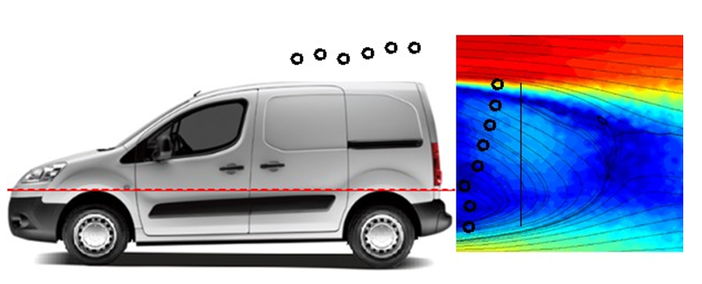
Figure 1: mean flow field (color map and streamlines) in the wake and pressure distribution (open dots) at the rear and top of a commercial car.
Recent Publications
1. M Grandemange, O Cadot, M Gohlke (2012) Reflectional symmetry breaking of the separated flow over three-dimensional bluff bodies. Physical Review E. 86(3):035302.
2. M Grandemange, M Gohlke O. Cadot (2013) Turbulent wake past a three-dimensional blunt body. Part 1. Global modes and bi- stability. Journal of Fluid Mechanics. 722:51:84.
3. M Grandemange, M. Gohlke, O. Cadot (2014) Turbulent wake past a three-dimensional blunt body. Part 2. Experimental sensitivity analysis. 752:439-461.
4. A Evrard, O Cadot, L R Pastur (2015) Imperfect supercritical bifurcation in a three-dimensional turbulent wake. Physical Review E. 91(6):063005.
- Video Presentation
Chair
R S Srivastava
Defence Science Centre, India
Biography:
R S Srivastava has been working in the field of Fluid Mechanics for a considerable period of time. He has by now published more than 70 research papers on flow through curved tubes, shock wave diffraction, heat transfer, flow through rotating pipes and non-Newtonian fluids. His work has received international recognition and has been referred widely and profusely in international journals and books by very eminent persons in the area. His work on flow through curved pipes has found application in most of the disciplines in Science, Engineering and Medicine. His prediction of position of maximum axial velocity in curved pipes for different parameters of Mc Conalogue has tallied extremely well with ultrasound measurements. He has written two books: i) “Turbulence (Pipe Flows)” ii) “Interaction of Shock Waves”. He has worked with Prof. Sir James Lighthill, F R S, Prof. I I Glass and Prof. Akira Sakurai at Imperial College, London, Institute for Aerospace Studies, Toronto, Tokyo Denki University, Tokyo, respectively. He has delivered several lectures at many international symposia.
Abstract:
Lighthill (1949) investigated the diffraction of normal shock wave past a bend of small angle d. He used small perturbation theory to linearize the problem and solved the problem through Busemann transformation and complex variable technique. He obtained pressure distribution over the wall for several Mach numbers of the shock wave. Lighthill’s theoretical results were tested experimentally (1950). Sakurai and Takayama (2005) extended the theory of Lighthill to larger d through singular perturbation theory. Shock diffraction phenomenon provides insight into vortex development and vortex shock interaction whose applications include noise control, propulsion or wing aerodynamics. In relation to this Srivastava (2013) predicted vorticity distribution over diffracted shock both from Lighthill’s theory and Sakurai and Takayama’s theory. Srivastava (1968) developed the theory of diffraction of oblique shock waves (consisting of incident and reflected shock waves) analogous to the theory of Lighthill. Srivastava gave the pressure distribution over the wall surface when the relative outflow behind the reflected shock wave before diffraction is subsonic and sonic. Subequently Srivastava and Chopra (1970) obtained the pressure distribution on the wall when the relative outflow behind the reflected shock wave before diffraction is supersonic. The results of Srivastava and Chopra (1970) were tested experimentally at the Institute of Aerospace studies, University of Toronto, Canada by Srivastava and Deshambault (1984). The results were found to be extremely satisfactory. More work on this subject has been carried out by Liet et al (1994) and by Heilig (1995, 1996), at the Ernst Mach Institute, Germany.
Recent Publications
1. Lighthill MJ (1949) The diffraction of blast-1. Proc. Roy. Soc. A. 198: 454-470.
2. Fletcher CH, Weimer DK and Bleakney W (1950) Pressure behind a shock wave diffracted through a small angle. Physical Review 78(5): 634-635.
3. Sakurai A, Takayama F (2005) Analytical solution of a flow field for weak Mach reflection over a plane surface. Shock Waves. 14: 225-230.
4. Srivastava RS (2013) On the vorticity distribution over a normal diffracted shock for small and large bends. Shock Waves 23(5): 525-528.
5. Srivastava RS (1968) Diffraction of blast wave for the oblique case. British Aeronautical Research Council. Current Paper No. 1008 (Ministry of Aviation).

















